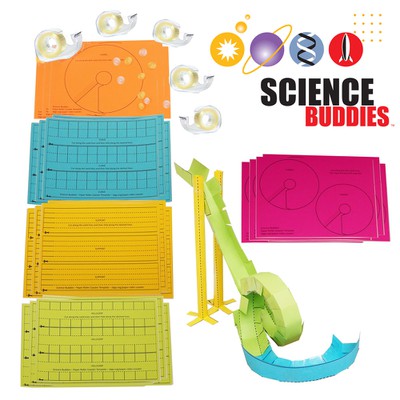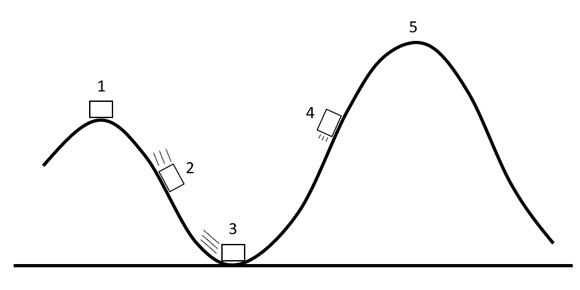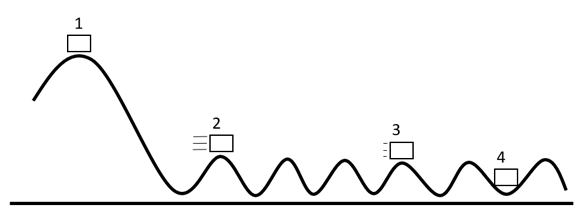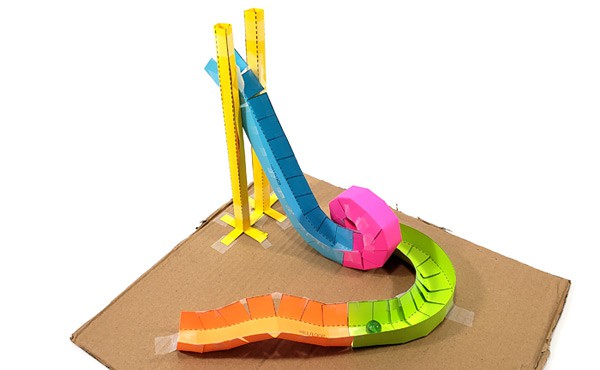Summary
Overview
What goes up, must come down in this thrill-seeking lesson plan! How much energy does a roller coaster car need to make it through a loop? In this lesson your students will learn about kinetic and potential energy as they build their own roller coasters from simple classroom materials.
Learning Objectives
- Design and build a working roller coaster.
- Explain how conservation of energy applies to the roller coaster, in terms of gravitational potential energy, kinetic energy, and friction.
NGSS Alignment
This lesson helps students prepare for these Next Generation Science Standards Performance Expectations:- MS-PS3-2. Develop a model to describe that when the arrangement of objects interacting at a distance changes, different amounts of potential energy are stored in the system.
- MS-PS3-5. Construct, use, and present arguments to support the claim that when the kinetic energy of an object changes, energy is transferred to or from the object.
|
Science & Engineering Practices
Constructing Explanations and Designing Solutions.
Apply scientific ideas or principles to design, construct, and/or test a design of an object, tool, process, or system.
Construct an explanation that includes qualitative or quantitative relationships between variables that predict(s) and/or describe(s) phenomena. |
Disciplinary Core Ideas
PS3.A: Definitions of Energy.
Motion energy is properly called kinetic energy; it is proportional to the mass of the moving object and grows with the square of its speed.
A system of objects may also contain stored (potential) energy, depending on their relative positions. PS3.B: Conservation of Energy and Energy Transfer. When the motion energy of an object changes, there is inevitably some other change in energy at the same time. |
Crosscutting Concepts
Energy and Matter.
Energy may take different forms (e.g. energy in fields, thermal energy, energy of motion).
The transfer of energy can be tracked as energy flows through a designed or natural system. |
Materials
 Image Credit: Science Buddies
Image Credit: Science Buddies
- Cardboard bases (optional)
- Scissors
- Marbles
- Tape
- Video instructions are available in English and Spanish
- Roller coaster template sheets, you will need to download and print these on cardstock
- If you do not have a printer, or prefer the convenience, a Classroom Paper Roller Coaster Kit
is available from our partners at Home Science Tools. The convenient kit has:
- Roller coaster templates pre-printed on colorful sheets of cardstock (40)
- Tape (5 rolls)
- Corrugated cardboard bases (10)
- Marbles (10)
- If you have fewer students, individual Paper Roller Coaster Kits are also available
Disclaimer: Science Buddies participates in affiliate programs with Home Science Tools, Amazon.com, Carolina Biological, and Jameco Electronics. Proceeds from the affiliate programs help support Science Buddies, a 501(c)(3) public charity, and keep our resources free for everyone. Our top priority is student learning. If you have any comments (positive or negative) related to purchases you've made for science projects from recommendations on our site, please let us know. Write to us at scibuddy@sciencebuddies.org.
Background Information for Teachers
This section contains a quick review for teachers of the science and concepts covered in this lesson.Roller coasters are an excellent way to teach your students about conservation of energy. Gravitational* potential energy is the amount of energy an object has due to its mass and its height off the ground. Kinetic energy is the amount of energy an object has due to its mass and its speed. When a roller coaster car reaches the top of its very first hill, it is very high off the ground but moving very slowly. That means it has a lot of potential energy but very little kinetic energy. When it goes over the top and starts going down the hill, its height rapidly decreases and its speed increases—the potential energy is converted to kinetic energy. When it goes back up the next hill or loop, its height increases and it slows down—some of the kinetic energy is converted back to potential energy. As the car goes on through the coaster track, energy is continually converted back and forth between kinetic and potential energy, but the total amount of energy is conserved. The "Roller Coaster Model Interactive" reference in the Additional Background section shows this with an interactive animation.
If you watch the roller coaster model animation, you will notice that the roller coaster car goes back and forth forever. In reality, you know that can't be true—eventually the car would slow down and come to a stop because of friction. While some energy is "lost" due to friction with the track and air resistance, this energy does not "disappear." It is converted to thermal energy. The total amount of energy is still conserved.
Why is this information useful? It puts practical limits on the length of the track and the height of loops/hills the roller coaster can go through. Conservation of energy means that, assuming the coaster cars are only towed up the first hill (and not any subsequent hills), a roller coaster can never make it through a loop/hill that is taller than the initial hill. Doing so would require more energy than the coaster had available to begin with, as shown in Figure 1. Because of friction, eventually a roller coaster will slow down and come to a stop, even if all the subsequent hills/loops are shorter than the first one (Figure 2).
 Image Credit: Ben Finio, Science Buddies / Science Buddies
Image Credit: Ben Finio, Science Buddies / Science Buddies
Figure 1. In this figure: the coaster starts out at the top of the first hill with maximum potential energy (PE) and almost no kinetic energy (KE) (1). As it goes down the hill, it gains KE and loses PE (2). At the bottom of the hill, it has maximum KE but almost no PE (3). As it goes back up the hill, it loses KE but gains PE again (4). It can never get to the top of the second hill because it does not have enough energy (5). Instead, it will roll back down and eventually settle at the bottom (3).
 Image Credit: Ben Finio, Science Buddies / Science Buddies
Image Credit: Ben Finio, Science Buddies / Science Buddies
Figure 2. In this figure, the second, third, and so on hills are all shorter than the first hill (1). However, because of friction, the roller coaster will still eventually come to a stop (4).
In this lesson your students will build their own roller coasters and experience these principles first-hand. You will challenge them to design a coaster that can make it through a large second hill/loop, and explain why their coaster can (or cannot) make it all the way to the finish.
*There are different types of potential (stored) energy, such as elastic potential energy (the energy you get from stretching a rubber band or a spring) or chemical potential energy (the energy stored in a battery). Usually the context makes the situation clear, so when talking about roller coasters we just say "potential energy" instead of "gravitational potential energy."






